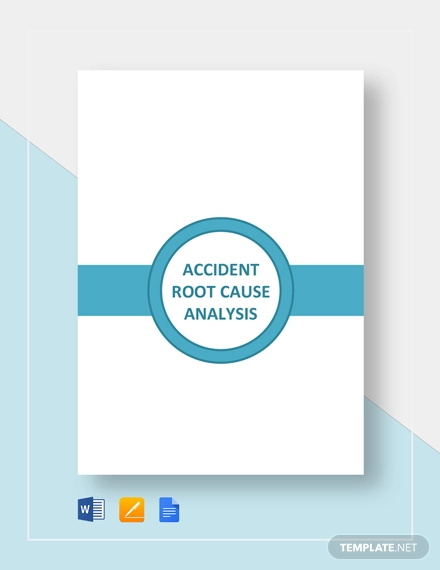What is Root Cause Analysis?
Problems will always be present which is why companies and organizations always need to be prepared on how to act on these. Some entities tend to implement resolutions without knowing what it is that they need to resolve. This common mistake can make situations worsen.
This is where the usage of root cause analysis becomes necessary and beneficial. Accurate analysis of the root cause of the problem allows businesses and other entities to develop efficient corrective actions. Identifying the true reason why a problem exists and continues to do so can make the management more aware on how they can fix and address issues accordingly.
Accident Root Cause Analysis Example

Purposes of Root Cause Analysis
Having one problem does not mean that you also have one root cause. There can be multiple causes that made the problem occur. This is applicable not only in root cause analysis but also on other kinds of analysis processes like a Comparative Market Analysis. Hence, you have to be keen when developing a root cause analysis that can assess all the areas of the problem that you would like to resolve.

The above mentioned information creates different reasons on why root cause analysis is needed by particular entities. A few of the purposes of root cause analysis are as follows:
- To describe the entire analysis process which can help involved entities to be aware of their responsibilities
- To assess the relation of various factors involved in the existence of the problem
- To define the specific problem that is essential to be addressed by the business and its management
- To gather information that can specifically point out the problem at hand and the time frame in which it has been around. You may also see cluster analysis.
- To have a timeline that the business can refer to in relation to the actual impacts of consequences due to the problem
- To develop a process of predicting possible problems which can help the company become more aware of threats
- To measure the magnitude of problems and its effects
- To fully determine the actions, or the lack there of, that worsened the condition of the problem
- To ensure that there a little to no possibility for the same problem to occur again
- To find solutions that can be used in the current operations of the business and in the future as well
- To resort to alternative activities to minimize the problem occurrences
Steps Involved in Root Cause Analysis
It is important for you to make your root cause analysis understandable, relevant, trustworthy and comprehensive. If you want to come up with an effective analysis example, you have to present the elements of the analysis in a precise and sequenced manner. Listed below are the initial steps that you can follow if you want to develop a root cause analysis that works.
1. Know the problem that your business is currently facing. You cannot proceed to any root cause analysis procedures if you are unaware of what it is that you would like to resolve. You may also see operational analysis.
2. Once you are already aware of the problem to be reviewed, specifically describe the problem and its effect to different areas of the business. What kind of problem is the business facing? What constitutes to this problem and how can it affect the operations of the company or the stakeholders of the business? Ask yourself these questions so you can discuss the problem thoroughly. You may also see organizational analysis.
3. Gather relevant information which you think is helpful in knowing the root cause of the problem and other information related to it. You can do this by resorting to surveys, researchers, questionnaires, close group discussion and interviews. You may also see business analysis.
4. Assess the problem and its existence based on the information that you have gathered. This will allow you to know the potential causes of the problem and the percentage of people who believes that it is really a threat to the development of the business.You may also see process analysis.

One you have already done the initial phases of root cause analysis, you then need to be more observant and thorough when developing the actual document. The next steps that you need to do after assessing the problem are as follows:
1. Create a draft that can list down all the possible causes that you have thought of. From here, remove the causes which you think are not that strong or heavy in terms of its weight to the problem existence. You can go back to this list if you have failed to know the root cause of the problem from your top selection. You may also see need analysis
2. Identify possible solutions that can prevent the problem from happening again. Doing this can help you address the issues that you have listed in a precise manner.
3. It is essential for you to implement the changes that you have come up with from the result of the root cause analysis. Always track the implementation of each possible solutions for you to pin point the best action to maintain and execute whenever the problem exists again in the future. You may also see company analysis.
4. Evaluate whether the changes that you have made reduced the impacts of the problem, or furthermore made the problem non-existent. Proper assessment is necessary as this will allow the business to be more aware on what to veer away from may it be related to the workforce, the management, other stakeholders or even external factors. You may also see analysis essay.
5. Always have a notepad or any writing material beside you whenever assessing root causes and problems so you can properly list down all your findings and other relevant information that you would like to record. This can help you have first hand information on how to handle problems. You may also see investment analysis.
Things to Remember When Implementing Root Cause Analysis
It is highly-recommended for you to have different angles of analysis. Root causes may be hard to pin point especially if you are facing a problem that you are unaware on how to handle. If necessary, ask questions from people with various points of view and those who have experienced the problem and its effects first hand. Exploring the problem and the incidents where it occurred can help you properly identify the root cause that you need to review and look into. You may also see literacy analysis.

There are important details that you always have to be observant of so you can ensure that you can come up with a usable root cause analysis. A task checklist will be very helpful if you need a guide related to this matter. Listed below are some of the things that you need to remind yourself of when implementing root cause analysis.
1. Ensure that all the entities who are involved and affected in the problem are aware of the root cause analysis. You have to gather first hand information that will allow you to get the support of the people to whom the result of the root cause analysis is beneficial to. You may also see financial analysis.
2. Keep in mind that root cause analysis can provide a lot of advantages and benefits to the business or any organization who will use it. If people within your group tend to react to problems easily without doing anything to resolve it, the root cause analysis that you will come up with should be the medium where their focus can be placed in resolutions rather than on the negative effects of the problem. You may also see SWOT analysis.
3. Have a problem statement that is easy to understand. People need to know what they are currently faced with so they can also be aware on how to act accordingly to lessen threats and impacts. Describing the problem is not enough. Your root cause analysis must have a thorough discussion of the problem and how people can help to remove it. You may also see feasibility analysis.

Is Your Root Cause Analysis Effective?
There are objective metrics and measures that you can use depending on the problem that your business is currently facing. Moreover, you can seek opinions of the management and other stakeholders when implementing root cause analysis. Aside from these actions, some of the ways on how you can ensure that you have an effective root cause analysis include the following:
1. Reports and other instances about the problem existence must be documented. If you want to assess the root cause of problems, you must have a database as your reference. The problem with this is that people within the organization do not want to be blamed for anything. Hence, there might be information that will not be presented.
Your responsibility is to ensure that incident reports are reviewed accordingly and that all materials that you will use as sources are credible. To avoid conflicts in the working environment, most incident reports about the problem are usually done in an anonymous manner. You may also see requirements analysis.
2. If there are reports that are given to you, do not just focus on what has been stated. Review reports thoroughly and identify loopholes or inconsistencies. Do not easily believe every detail that is presented to you. Ensure that your root cause analysis contains the narrowed down information that you need to specifically resolve a problem. You may also see fault tree analysis
3. All the details, data and information that you have collected must be relevant and related to the problem to be analyzed. Your output will depend on the content that you have put together. If your analysis uses irrelevant information, then it is most likely that you will fail to deliver working results. You may also see decision tree analysis.
4. Create call to actions that can supply the needs of your analysis and recommendations. You have to make sure that corrective measures will be made so that you can also assess the effectiveness of your efforts to remove the problem. You may also see formal analysis.
Tips for Root Cause Analysis Execution
Root cause analysis can be a trial and error procedure as long as you have not dig deep enough in what causes the problem of the business to arise and exist. Hence, root cause analysis can be tedious and tiring. However, there are some ways on how you can efficiently execute the call to actions that you are tasked to do. You may also see regression analysis

If you are unaware on how to maximize your efforts and time while getting your desired results, there are some guidelines or simple tips that can help you with that. Here are some useful tips that you can use within the implementation of your root cause analysis:
1. Ensure that you will have a systematic way of executing root cause analysis processes. The way you perform this undertaking can affect the output that you will have in the end. Hence, it is of utmost important to remain organized within the entirety of the analysis. You may also see cost benefit analysis
2. It is essential for team collaboration to exist during root cause analysis. This can make objectivity be applied when identifying the factors that allows a problem to exist or worsen. Doing a root cause analysis alone can potentially be influenced by the biases of the person who is tasked to implement processes by himself or herself. You may also see activity analysis
3. Properly showcase the linkages or the relationships of the factors that affected the result/s of the analysis. Know how to provide proper and relevant details related to the root causes and their contributions to the problem that the organization, group or company is currently experiencing. You may also see impact analysis.
4. The root causes that you will come up with must have solid and credible foundations. Evidences and proofs are essential as these items can validate your claims.
Root Cause Analysis Documentation
The last thing that you need to do once you have already implemented root cause analysis and identified the proper action to do per problem is to maintain a record of the entire undertaking. Document the phases that you have taken and make sure that you will record all your findings for referencing purposes.You may also see factor analysis

Maintain files that you have put together due to your root cause analysis as you can review these to identify trends and other important matters about solving problems that your company might be exposed with. With the information that you are now aware of, it will be best to put things into action. Develop a root cause analysis now and help your business find ways on how to resolve the problems that it currently has. You may also see risk analysis.


